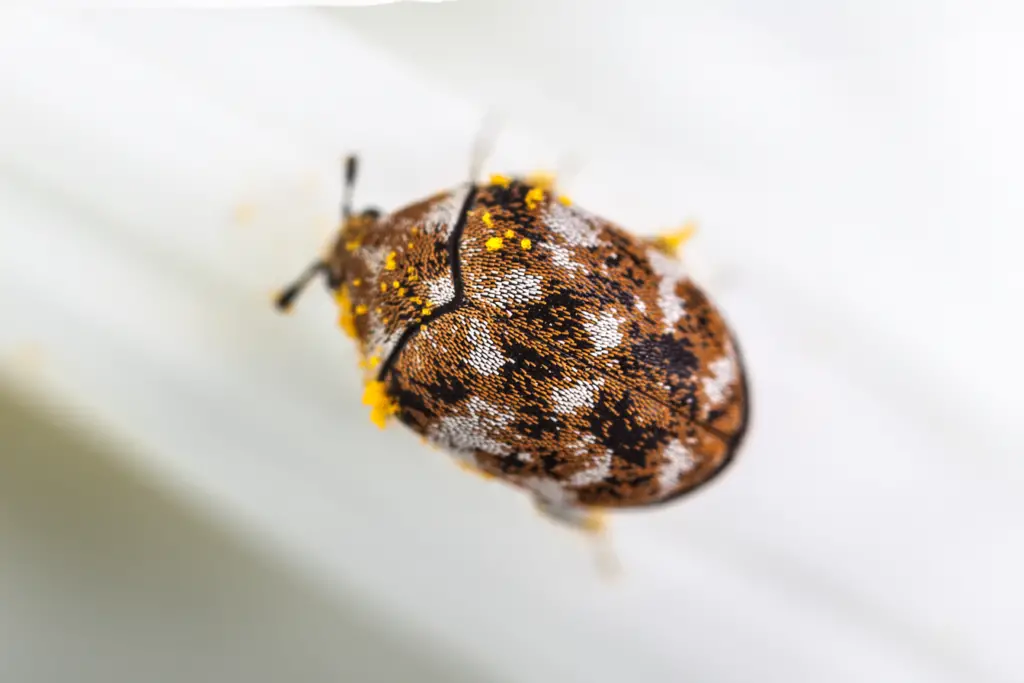
When you find red, itchy welts on your skin, it’s natural to wonder about the cause. You might start to question whether the small carpet beetles you’ve noticed at home are the culprits. Contrary to some fears, carpet beetles do not burrow into human skin. They are, however, known to cause skin irritation in some cases.
The reason you might experience discomfort is largely due to an allergic reaction to the tiny hairs or fibers on the larvae of these beetles, not from a bite or burrowing action. Contact dermatitis is a common reaction, resulting in redness, itching, and small raised bumps. Understanding that these nuisances don’t actually invade your skin might be a relief, but it doesn’t lessen the annoyance of an infestation in your living space.
Understanding Carpet Beetles
Carpet beetles are common household pests that you might encounter, yet they do not burrow into your skin like some other insects.
Characteristics of Carpet Beetles
Carpet beetles are small, oval-shaped insects that can come in a variety of colors including black, white, yellow, and brown, often with a mottled or speckled pattern. The hairs on their bodies are what can cause skin irritation, but it’s important to understand that this isn’t a result of burrowing but from contact with these tiny fibers.
Adult carpet beetles typically range in size from 1.7 to 3.5 mm and prefer to lay their eggs in quiet, undisturbed areas of your home where they have access to a food source. This makes natural fibers and food debris attractive spots for them.
Life Cycle of Carpet Beetles
Carpet beetles, like many insects, undergo a complete metamorphosis during their life cycle which includes four stages: egg, larva, pupa, and adult.
- Egg: Eggs are laid in locations where larvae will have immediate access to food upon hatching.
- Larva: The larval stage causes the most damage to household items, particularly those made of animal-based materials such as wool, silk, or leather.
- Pupa: During this stage, carpet beetles undergo a transformation into their adult form.
- Adult: Once they have reached maturity, adult carpet beetles primarily feed on pollen and nectar and don’t cause damage to household items.
Carpet Beetles and Human Skin
When dealing with carpet beetles, it’s important for you to distinguish between reality and myth, as well as understand how your skin might react to these insects.
Myths Versus Facts
- Myth: Carpet beetles burrow into your skin.
- Fact: Carpet beetles do not burrow into human skin. They feed on natural fibers, not flesh.
Reactions to Carpet Beetles
- Common reactions: Your skin might show signs of irritation such as itching or redness in response to contact with carpet beetle larvae hairs.
- Severe cases: Some individuals may experience more pronounced symptoms including blister-like lesions. If you suspect a severe reaction, consult a medical professional.
Preventing Carpet Beetle Infestations
To secure your home against carpet beetle infestations, it’s crucial to implement thorough inspection practices and use natural deterrents effectively.
Inspection and Identification
First, inspect your home regularly, especially the fabrics and pantry areas where these pests are likely to reside. In your fabrics, you’re looking for irregular holes or shed skins, and in the pantry, keep an eye out for damaged packaging or spilled grains.
Natural Remedies and Preventative Measures
Implementing natural remedies can be highly effective in preventing carpet beetles. Regularly vacuum your carpets and furniture to remove any eggs or larvae, and consider using vinegar as a natural repellent by lightly misting susceptible areas. For persistent problems, boric acid can be used along carpet edges to eliminate larvae.
Keep your textiles clean – store clothing and fabrics in well-sealed containers and laundering items regularly. Your diligence with these preventative measures can greatly reduce the risk of carpet beetle infestations.
Frequently Asked Questions
In this section, you’ll find clear answers to some common queries about carpet beetles, their effects on your skin, and controlling their presence in your home.
Can carpet beetles cause a rash on human skin?
Yes, carpet beetles can cause skin irritation. Contact with their hairs can lead to allergic reactions, such as dermatitis, which results in red, itchy bumps.
What are the signs of a carpet beetle infestation in a home?
Look out for shed skins and fecal pellets, as well as damage to fabrics. Signs of an infestation can also include sneezing or a runny nose for those with allergies to these insects.
How can one safely eliminate carpet beetles from the house?
Regular cleaning is crucial. Focus on removing hair, dead insects, and spilled food, as these can attract beetles. For serious cases, consulting a professional pest controller is advisable.
What do carpet beetle larvae look like?
Carpet beetle larvae are small, elongated, and covered in bristles. Typically, they are light brown or black and possess banded patterns on their bodies.
Are carpet beetles attracted to human hair?
Carpet beetles aren’t specifically attracted to human hair; however, they do feed on materials like hair that accumulate under furniture or in other areas around your home.
Do carpet beetles crawl on people while they sleep?
While not common, carpet beetles may inadvertently crawl on people, as they are generally active at night. However, they do not bite or burrow into the skin.
Driven by a passion for those tiny creatures that rule our world, we at Bug Domain strive to be your go-to resource for information on insects.



